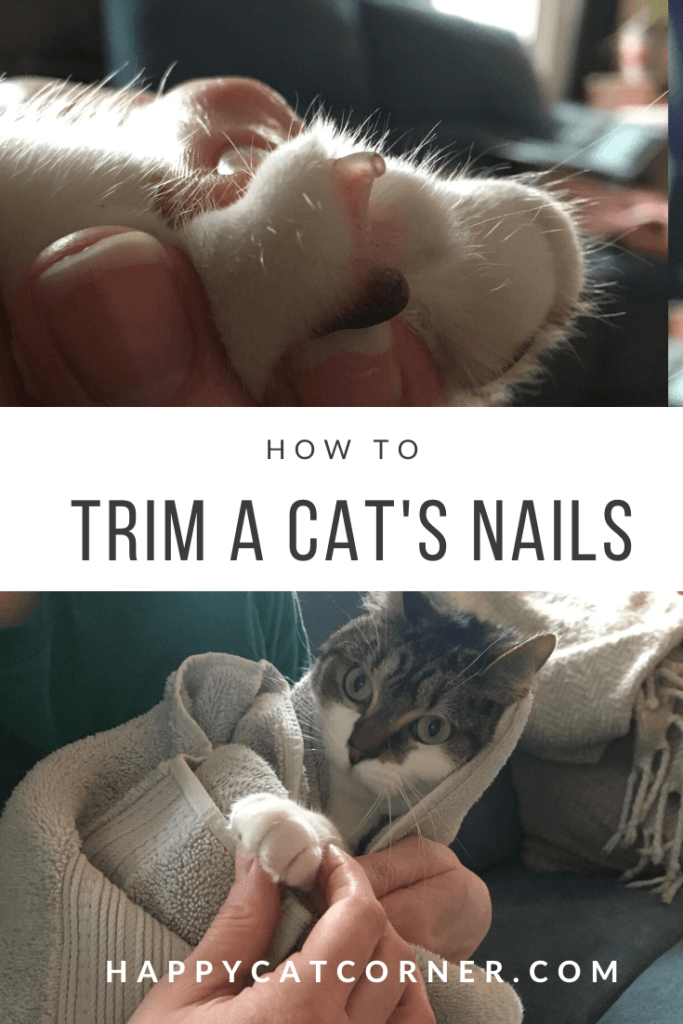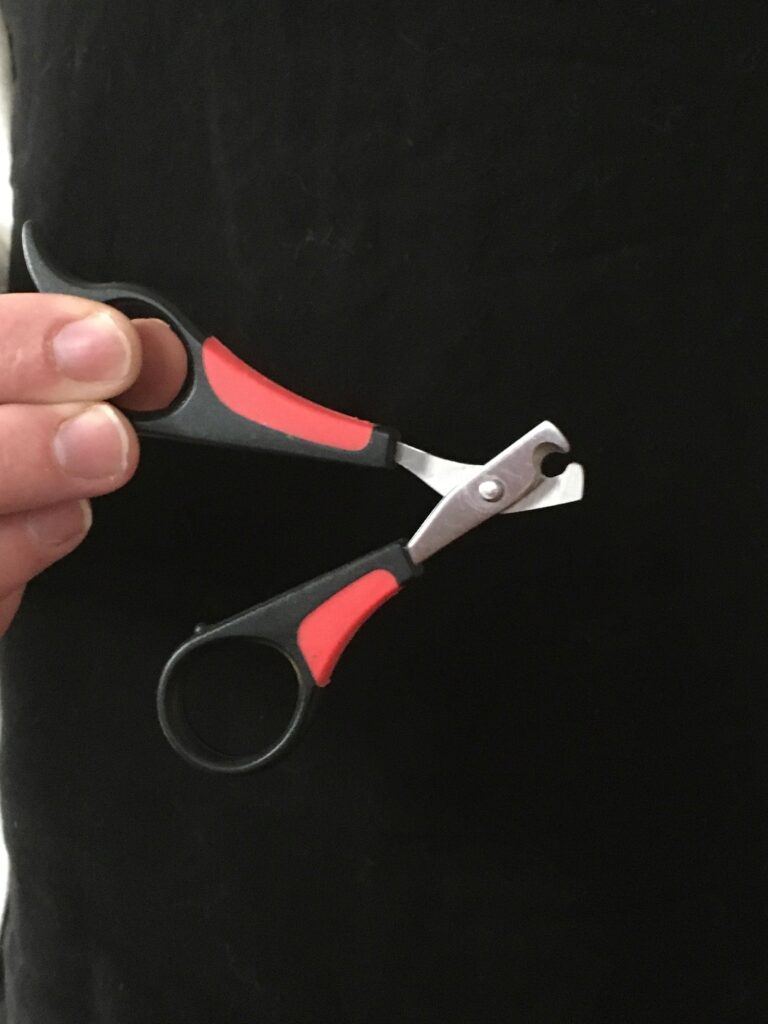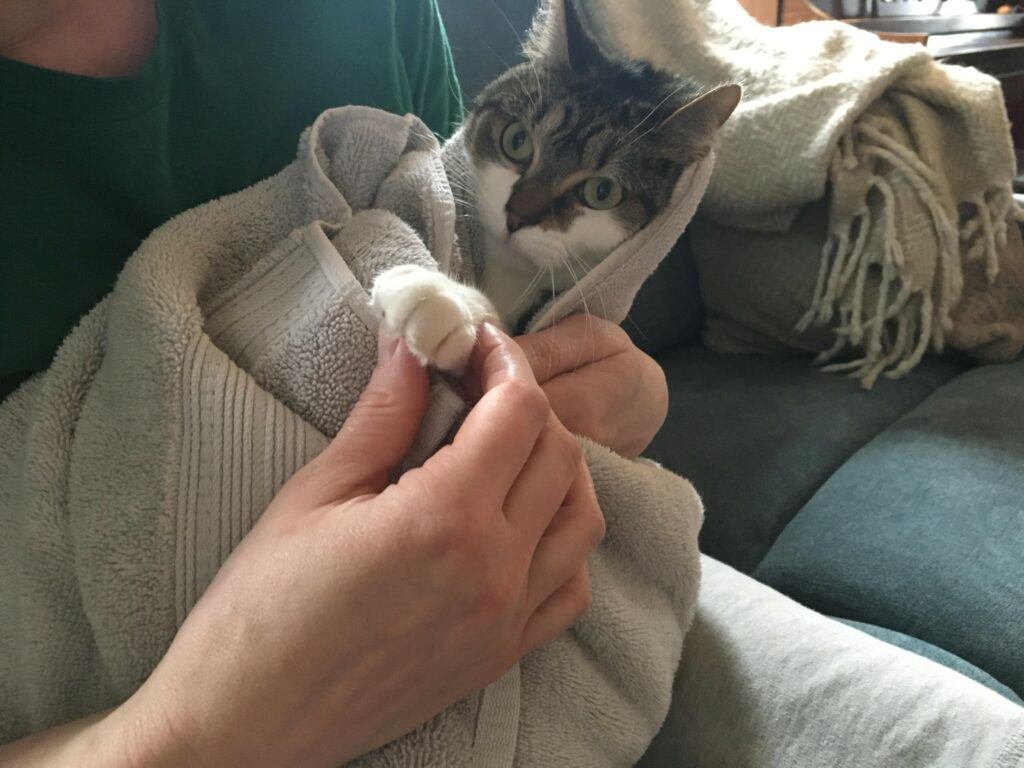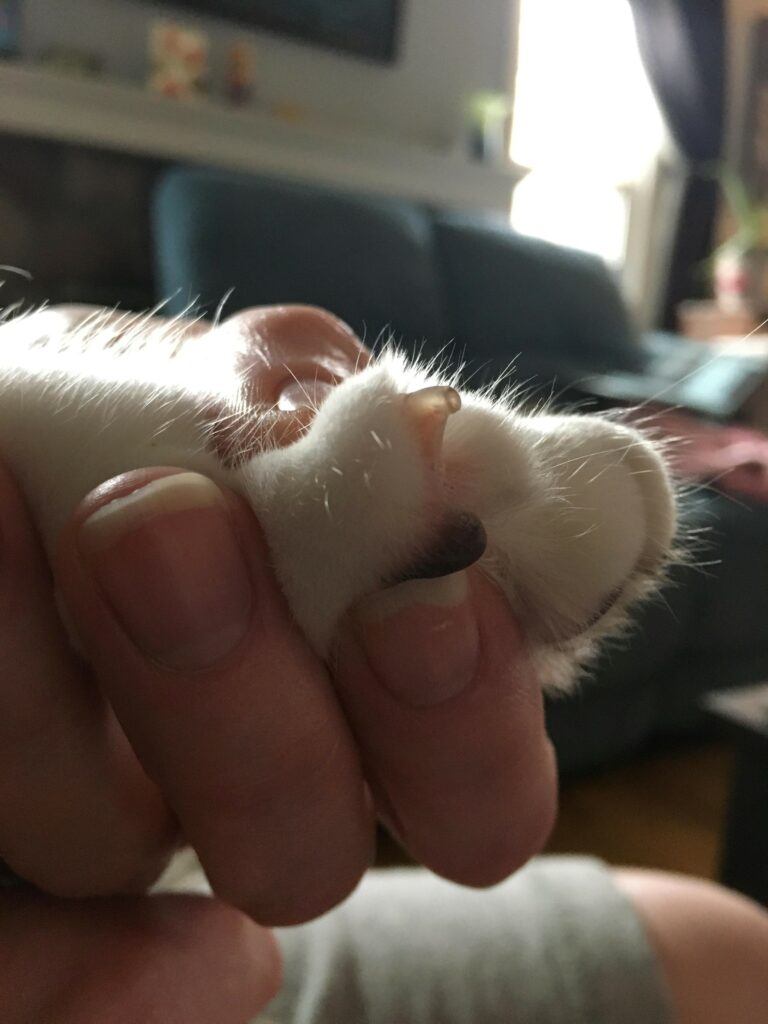This post may contain affiliate links. This means I may receive a small commission if products are purchased through them. All opinions are honest and remain my own.

This may sound a bit odd, but I’ve always loved trimming cat nails. There’s a sense of accomplishment that follows the task and I like knowing that my kitties are protected from getting their claws stuck in blankets for a while. I’m even the designated claw trimmer when I go to visit my sister and some of my other cat-owning friends. I’m going to share with you my tips and tricks for how to trim a cat’s nails at home because I know that for many people (and cats) this can be an unpleasant process.
How easy is it to trim a cat’s nails? It depends on the cat!
The level of difficulty involved in trimming your cat’s nails will depend heavily on the cat. For my cat Bear, trimming his nails is a breeze. He’s one of those VERY docile cats that lets me carry him around like a baby, or hold him up in the air like we’re reenacting The Lion King. My other cat, Chickadee, is a different story. Poor Chicky doesn’t like to be picked up and is incredibly sensitive to touch. Trimming her nails is a challenge, but if done properly is entirely doable.
Why do I need to keep my cat’s claws cut?
There are a few reasons why it’s a good idea to trim your cat’s nails. Taking off the razor-sharp pointed ends of kitty’s claws will make daily life much more comfortable for both you and your cat. My cat likes to knead my tummy sometimes, and trimming his nails ensures I don’t end up full of puncture holes. Keeping nail length in check also benefits your cats. It helps prevent painful consequences, like broken claws that can happen when cats get their long nails stuck in carpeting or curling nails that can prevent them from fully retracting and end up growing back into the nail pad. Finally, trimming nails helps minimize damage to woodwork and furniture, and that is a very good thing.
It is especially important to trim indoor cats’ nails. Outdoor cats can keep their own nails trimmed by climbing and clawing on trees, among other outdoor activities. Indoor cats can use scratching posts to help with their nail length, but it is usually insufficient to keep the nails short enough.
So to sum it up, these reasons are why it’s important to keep your feline’s claws trimmed:
- Helps prevent your cats from getting their claws stuck in things like carpet and furniture
- Prevents nail curling, which can lead to their claws not fully retracting and even growing back into the nail pad
- Minimizes damage from clawing on both people and furniture
Tools you’ll need for doing this at home

You don’t need anything fancy to trim your cat’s nails. The best tool is a simple pair of clippers that are specifically designed for cat’s claws. You can find them in the pet aisle at most grocery stores, any pet store, or of course online. They are curved to accommodate the curvy shape of a cat’s nails. Some people like to use human nail clippers, but I haven’t tried this myself. The cat scissors work very well for me so I will stick with those.
The second thing you may want to have is a towel or blanket to wrap your kitty in while you cut her nails. ( I don’t need a towel for Bear, but for Chickadee it’s an absolute necessity.)
- Cat nail clippers (if you don’t have it, nail clippers for humans will work too)
- A towel or blanket for restraint (if necessary)
- A partner (can make it easier, especially for difficult cats)
How to Begin
Step 1: Pick the right time (when your cat is in a relaxed or sleepy mood)
You will want to begin by making sure your cat is as comfortable as possible. The best time to cut nails is when your cat is already in a sleepy, relaxed state. After a meal or when your cat is feeling snuggly could be good options. Don’t attempt to nail trim when your cat is all riled up or in a feisty mood.
Step 2: Position them properly (if necessary, restrain with towel or blanket)
Next, cradle your cat with her back to you. If your cat is wriggly and hard to keep still, you will want to wrap her in a large bath towel. Hold her firmly, but make sure to talk to her in a comforting voice. Start with one paw at a time, keeping the other 3 tucked inside the towel. I call this The Kitty Burrito Method.

Step 3: Massage paws gently to make them retract
When your cat is in place, start massaging her paw. A lot of cat don’t like their feet touched, so be as gentle as possible and try to get her used to your hand on her paw. Using your thumb and forefinger, apply just enough pressure to each digit so that the claw extends out all the way. Get both you and your cat used to this pressure and process of exposing the claws so that the nail trimming can begin.
Step 4: Start trimming, make sure to cut ABOVE the pink part
Now you are ready to trim. It’s important to be very careful and take your time. If your cat is just too wriggly or upset, break up nail trimming into two segments. One paw now and the other paw later.

Cut each claw carefully, making sure not to cut the center pinkish part called the “quick.” This is where the cat’s nerve endings and blood vessels are, and it may be longer or shorter on different nails. Cutting into this would cause bleeding and be extremely painful for kitty, so really be mindful of this. It only takes one time for the cat to remember that this is painful, and may be less cooperative during nail trimming in the future.
Grab a partner if needed
A second person comes in handy during nail trimming. While you cradle kitty on your lap, your assistant can help hold her still. It’s critical that both you and the other person are both calm so as to keep your cat as relaxed as possible. The more relaxed everyone is, the quicker and easier nail trimming will be.
Step 5: Reward!
Make sure to reward your cat after a nail trimming session! Positive reinforcement will go a long way to establishing trust between you and your cat. I give Bear and Chickadee their favorite treats, as well as lots of pets.
How often do cats need their nails trimmed?
Cats need their nails trimmed every 10 days to two weeks. You will usually know when it’s time because when cats’ claws are too long they tend to get stuck in carpeting and fabrics around the house. All cats need to scratch; It is normal and healthy behavior. They scratch to mark territory, to remove the dead outer layers of nail, and to strengthen and stretch their muscles. Since your cat will always scratch, it’s important to keep up with their nail trimmings in a timely manner. Make it part of your routine – at least twice a month.
What to do if your cat won’t let you trim their claws?
Despite your best effort, some cats might make this task impossible for you. Remember that waiting till the cat is in the right mood (relaxed, sleepy) and doing it with a partner will make this much easier, but if that still doesn’t work, you can always take your cat to the professionals.
Many pet stores like Petco or local pet groomers will be more than happy to do this for you.
Summary
Let’s review the basics of cat nail trimming to ensure that you and your furry friend can live harmoniously together in a healthy, happy home.
- Make sure your cat is in a relaxed mood before you begin
- Cradle your cat on your lap with her back to you
- Practice pushing the pads of the cat’s paws to extend the claws
- Wrap your cat in a towel if dealing with a wriggler (kitty burrito)
- Cut the tip of the nail only, avoiding the quick
- Use a second person if necessary
- Reward and praise your cat after nail trimming

Leave a Reply